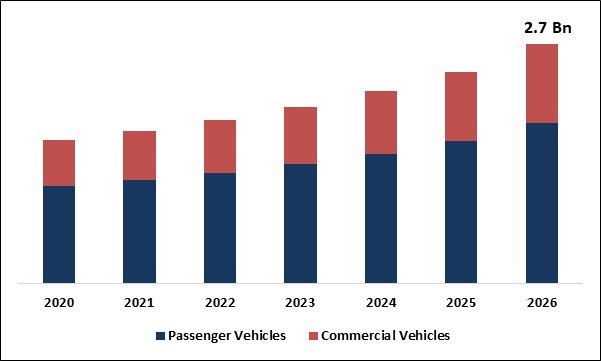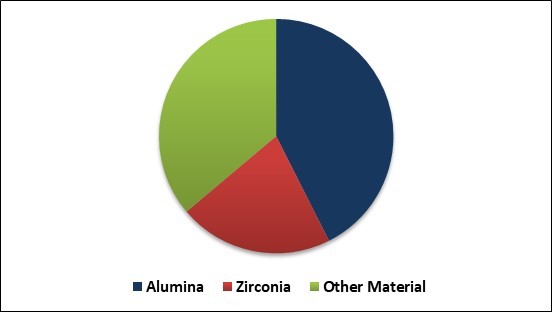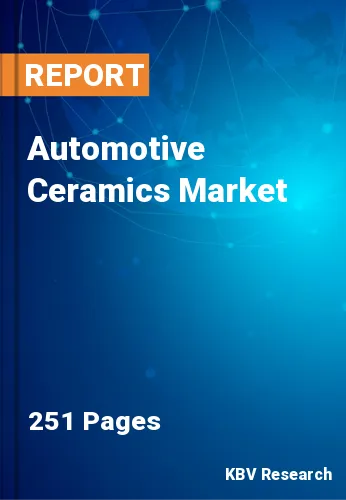The Global Automotive Ceramics Market size is expected to reach $2.7 billion by 2026, rising at a market growth of 8.9% CAGR during the forecast period. Automotive ceramics are specialized ceramic structural materials that are used to produce automotive parts. Components produced with automotive ceramics include spark plug insulators, different kinds of sensors, and catalytic converter supports. Ceramics possess excellent properties; therefore, most automotive product manufacturers prefer them. High melting point, low electrical and thermal conductivity, good resilience, and hardness and strength are essential properties.
Global Automotive Ceramics Market Size

Ceramic components support various important tasks in the automobile field to address the current challenges the automotive industry is experiencing. Such materials can work successfully under intense pressure and high temperature. However, the usage of ceramic materials in automobile components contributes to improved driving convenience, low wear, lower fuel consumption, and improved driving safety. The key factor increasing demand for automotive ceramics is the growing use of automobiles across the globe. Compared with alternatives such as metal and plastics, the high cost of such ceramics is the main factor that hampers demand for automotive ceramics.
Due to its unique properties, automotive ceramics find use in various automotive applications. Contrary to traditional materials (metals & plastics), automotive ceramic products are lighter in weight, longer-lasting, and have a stronger resistance to corrosion. During the forecast period, certain factors are projected to drive the automotive ceramics industry.
Automotive Ceramics Market Share

The zirconia oxide ceramic segment is expected to rise at the highest growth during the forecast period between materials. In applications needing superior properties, zirconia oxide ceramics are considered to have very good tolerance to crack propagation and are therefore favored to other ceramics. Automotive parts produced from zirconia oxide ceramics are costly relative to other ceramic oxide products. Because of properties such as high density, high fracture durability, high flexural strength, and strong chemical resistance properties, industry leaders choose zirconia oxide ceramics to manufacture vehicle components and parts.
Free Valuable Insights: Global Automotive Ceramics Market to reach a market size of $2.7 billion by 2026
Based on Application, the market is segmented into Passenger Vehicles and Commercial Vehicles. Based on Material, the market is segmented into Alumina, Zirconia and Other Material. Based on Regions, the market is segmented into North America, Europe, Asia Pacific, and Latin America, Middle East & Africa.
The market research report covers the analysis of key stake holders of the market. Key companies profiled in the report include Kyocera Corporation, Saint-Gobain Group, Corning, Inc., 3M Company, CeramTec GmbH, Morgan Advanced Materials PLC, IBIDEN Co., Ltd., NGK Spark Plug Co., Ltd., CoorsTek, Inc., and Elan Technology, Inc.
Market Segmentation:
By Application
By End-User
By Geography
Companies Profiled
The automotive ceramics market is projected to reach USD 2.7 billion by 2026.
There are several reason that cause high demand of this market one of them is increasing demand from automotive electronics applications and in battery-powered vehicles.
The Asia Pacific had the largest market share in the market and over the projected period, the region is expected to be the fastest developing regional market.
Kyocera Corporation, Saint-Gobain Group, Corning, Inc., 3M Company, CeramTec GmbH, Morgan Advanced Materials PLC, IBIDEN Co., Ltd., NGK Spark Plug Co., Ltd., CoorsTek, Inc., and Elan Technology, Inc.
Our team of dedicated experts can provide you with attractive expansion opportunities for your business.

